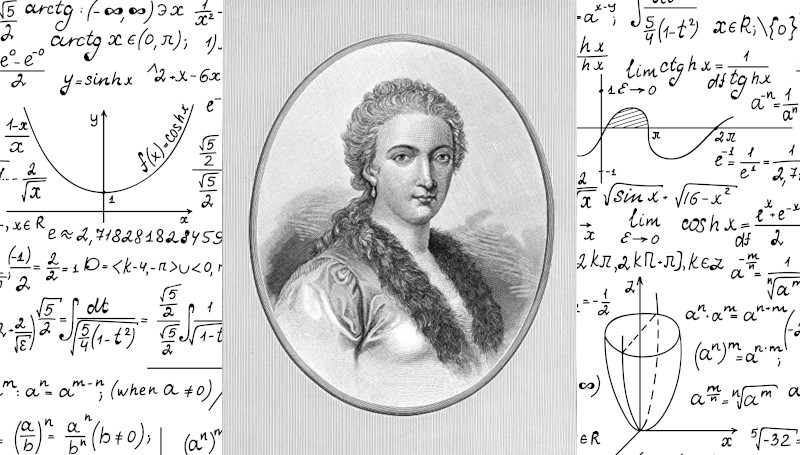
Maria Gaetana Agnesi (1718–1799) was a woman ahead of her time. A gifted mathematician, philosopher, and humanitarian, she is best known for her treatise Instituzioni analitiche and for the famous Witch of Agnesi curve—a mathematical construct whose name came from a translation error but whose elegance and teaching value remain unquestioned.
Born in Milan during the Enlightenment, Agnesi mastered numerous languages and became a public intellectual while still a teenager. Her story is a blend of genius, piety, and purposeful retreat from fame—a rare combination in any era.
A Prodigy in Enlightenment Milan
Maria was the eldest of 21 children in a wealthy silk-trading family. By age five, she was fluent in Latin, French, and Greek. At nine, she gave a Latin oration arguing for women’s right to education—a radical act in 18th-century Italy.
Her father hosted scholarly salons, where Maria debated with philosophers and theologians. These experiences shaped her into an independent thinker with both analytical rigor and moral depth. Her early education, directed by Jesuits and Piarists, emphasized both mathematics and theology, foreshadowing her later dual passions.
The Landmark Work: Instituzioni analitiche
Published in 1748, Instituzioni analitiche ad uso della gioventù italiana was the first complete textbook on both differential and integral calculus written by a woman. It was intended to simplify complex mathematical principles for students, especially Italian readers unfamiliar with Latin or French.
Agnesi’s two-volume work systematically introduced algebra, functions, limits, series, derivatives, and integrals. Its clarity earned it high praise from scholars, including those at the Paris Academy of Sciences and Empress Maria Theresa herself. It later circulated widely in Latin and English editions.
You can view a digitized manuscript via the Cambridge Digital Library.
The Curve with a Curious Name
Among the mathematical contributions in Agnesi’s book was a specific curve, originally called versiera in Italian, meaning “turning curve.” However, in English translation, versiera was confused with avversiera—meaning “witch.” Thus the Witch of Agnesi curve was born.
Ironically, the misnomer brought the curve—and Agnesi—lasting recognition in the world of calculus and mathematical education. For more on this naming story, visit Britannica’s entry.
Understanding the Witch of Agnesi Curve
The Witch of Agnesi curve is defined by:
y=a3x2+a2y = \frac{a^3}{x^2 + a^2}
This smooth, symmetric curve resembles a bell and is especially valued for its use in teaching calculus concepts. Key properties include:
-
Maximum at x=0x = 0
-
Horizontal asymptote as x→±∞x → ±∞
-
Area under the curve = πa2\pi a^2
Agnesi derived it using geometric intuition and calculus. Its behavior under differentiation and integration makes it a popular example in textbooks today.
Real-World Applications
Though its name may seem whimsical, the Witch of Agnesi curve remains important in modern science:
-
Calculus: Demonstrates slope, concavity, asymptotes, and area under a curve.
-
Statistics: Mirrors the shape of the Cauchy distribution.
-
Engineering: Shapes resembling the curve appear in optics, bridge arches, and wave attenuation.
Its relevance in both theoretical and applied contexts keeps Agnesi’s legacy alive in math and engineering education.
Explore similar curve applications in MacTutor’s biography.
From Mathematics to Ministry
In the 1750s, after publishing her treatise, Agnesi withdrew from public life. She declined an offer to lecture at the University of Bologna—even though she was appointed professor, making her the first woman to hold such a position.
She dedicated the rest of her life to charity. Working at the Ospedale dei Poveri in Milan, she supervised nurses, counseled the poor, and distributed her wealth. Her religious devotion deepened, and she lived simply, focusing on service over scholarship.
According to Smithsonian Magazine, her work in hospitals and convents left a lasting impression on local communities.
Legacy in Science and Beyond
Maria Agnesi’s influence continues through several key legacies:
-
Calculus Textbook: The first written by a woman, it became a reference across Europe.
-
Asteroid & Venus Crater: Asteroid 16765 Agnesi and a Venusian crater honor her name.
-
Modern Feminism: Scholars view her as a precursor to female empowerment in STEM.
-
Public Honors: Her name appears in science curricula and Italian educational broadcasts.
Her original letters, preserved in Milan’s Biblioteca Ambrosiana, show a woman of wit, humility, and immense moral clarity.
FAQ – About Maria Agnesi and the Witch of Agnesi Curve
Q1: What is the Witch of Agnesi curve?
It’s a smooth cubic curve defined by y=a3x2+a2y = \frac{a^3}{x^2 + a^2}. It helps explain calculus principles like asymptotes, area, and slope.
Q2: How did the curve get its name?
From a mistranslation of the Italian word versiera. English translators confused it with avversiera (“witch”).
Q3: What was Agnesi’s most famous work?
Instituzioni analitiche (1748), the first full calculus textbook by a woman.
Q4: Did she teach at the University of Bologna?
She was appointed professor but declined to teach, instead focusing on charitable work.
Q5: What did she do later in life?
She devoted herself to helping the poor, managing a hospital, and living a deeply religious life.





